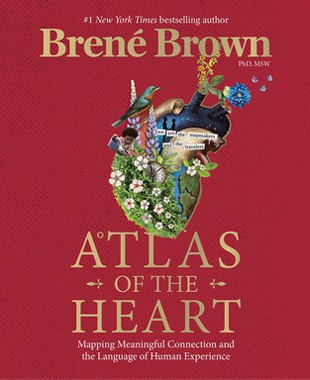Brené Brown is a #1 New York Times bestselling author, and this book will surely be as popular as any she has written. It is accessible, powerful, and packed with wisdom. Dr. Brown is one of our great contemporary spiritual teachers.
She shows us the “places we go when things are uncertain or too much.” These include stress, overwhelm, anxiety, worry, avoidance, excitement, dread, fear, and vulnerability. Who cannot relate to this, especially now? Then she explains the “places we go when we compare,” which include comparison, admiration, reverence, envy, jealousy, resentment, as well as two German words that may be unfamiliar: Schadenfreude and Freudenfreude. Schadenfreude “simply means pleasure or joy derived from someone else’s suffering or misfortune.” And Freudenfreude is its opposite; “it’s the enjoyment of another’s success. It’s also a subset of empathy.”
Always, Brown offers tools for both diagnosis and cure.
For example, she wants us to better understand the meaning and practice of compassion and empathy by contrasting them with pity and sympathy. She lists, for example, what she calls “Empathy Misses” such as “1. I feel sorry for you. (Sympathy versus empathy) 2. You should feel shame! (Judgment) 3. You’ve let me down (Disappointment), and 4. This feels terrible. Who can we blame? You? (Discharging discomfort with blame).”
She also advises us how the practice of compassion can lead to greater empathy: “Compassion is the daily practice of recognizing and accepting our shared humanity so that we treat ourselves and others with loving-kindness, and we take action in the face of suffering.” After quoting the American Buddhist nun Pema Chödrön, Brown offers this reflection as a parent: “Before I fully understood that the 'action' part of compassion wasn’t making things better or fixing, I would race to flip on the metaphorical lights when my kids were suffering. Now, I try to sit with them in the dark and show them how to feel the discomfort. Talk about moving gently toward what scares us. It’s so painful, but now … I can see how my kids are developing that sense of shared humanity. I’ve even had the incredible fortune of witnessing them moving toward others in pain without trying to solve.”
Then there is her teaching on anger — its causes and dangers — which we found extremely helpful. One section title is called “What I’ve Learned, Unlearned, and Continue to Learn About Anger. Dammit.” And here Brown’s honesty is what opens the reader to learning a great deal from her experiences. She writes: “We live in a world where it’s much easier to say 'I’m so pissed off' than 'I feel so betrayed and hurt.' It’s even easier to say 'I’m angry with myself' than 'I’m disappointed with how I showed up.'” Again, she offers tools to help.
One of the tools to understand how anger is masking something else in our lives is a colorful pie chart labeled “Behind This — Anger — Might Be …” The options she offers are many, such as embarrassment, jealousy, shame, sadness, confusion, grief, fear, anxiety, and loneliness. This was another reminder to us how necessary this book happens to be just now.
With similar diagnoses and tools throughout a rich book, many people will find themselves on a path toward emotional wholeness and cultivating meaningful connections with others. The latter, the author explains, comes from learning to ask better questions. Dr. Brown says:
“I’m going to start this section by acknowledging that I’ve been wrong about something for years. For two decades, I’ve said, 'We need to understand emotion so we can recognize it in ourselves and others.' Without exaggeration, I’ve said this thousands of times…. I no longer believe that we can recognize emotion in other people, regardless of how well we understand human emotion and experience or how much language we have…. So how do we know what other people are feeling? We ask them.”
And what keeps us from asking others how they feel? We don’t know yet how we feel ourselves. That’s what Atlas of the Heart is for.
